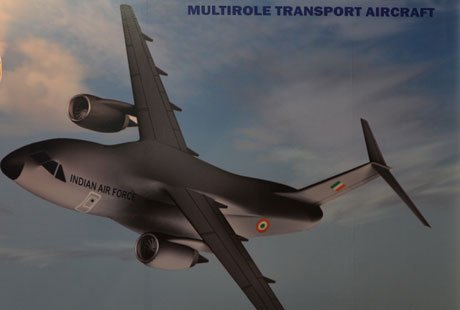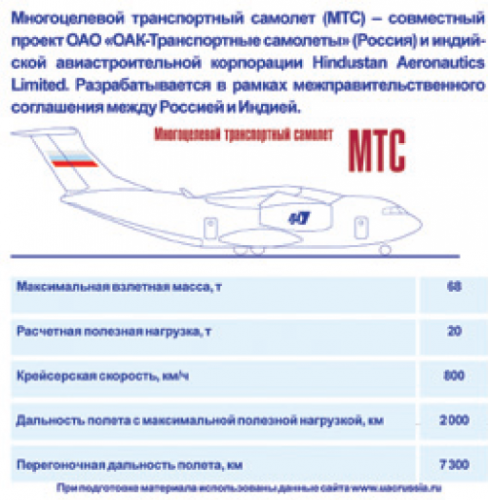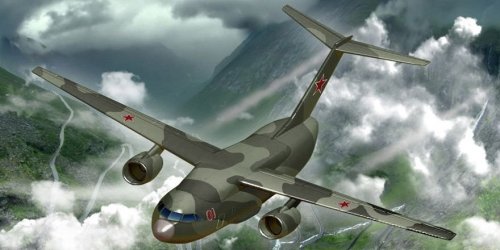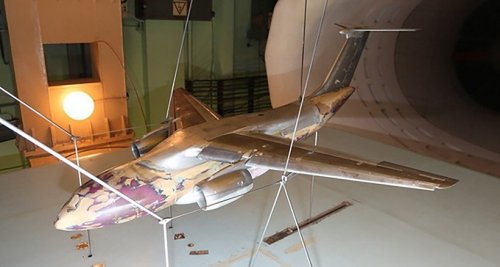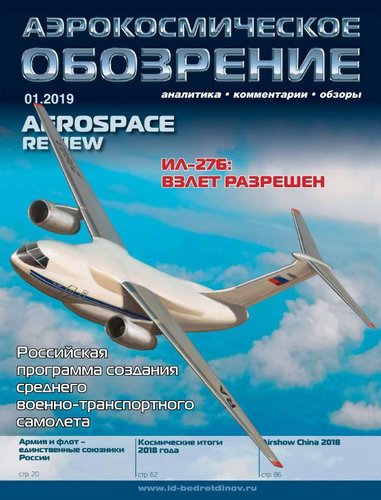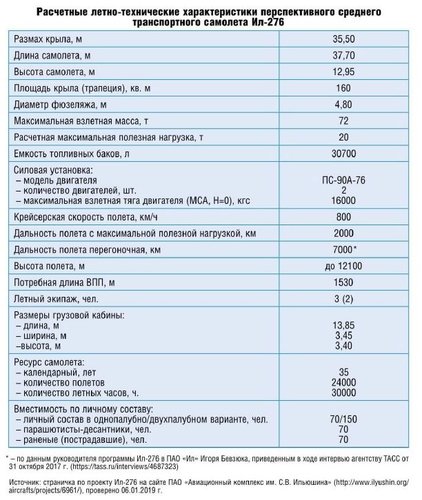You are using an out of date browser. It may not display this or other websites correctly.
You should upgrade or use an alternative browser.
You should upgrade or use an alternative browser.
UAC/HAL Multirole Transport Aircraft
- Thread starter Triton
- Start date
"Aero India 2017: Russia to offer transport aircraft to India on new terms"
Prashanth G N
February 16, 2017 14:23 IST
Source:
http://www.ibtimes.co.in/aero-india-2017-russians-offer-transport-aircraft-india-new-terms-716243
Prashanth G N
February 16, 2017 14:23 IST
Source:
http://www.ibtimes.co.in/aero-india-2017-russians-offer-transport-aircraft-india-new-terms-716243
The Russia has once again offered the Multipurpose Transport Aircraft (MTA) to India and is ready to co-develop the aircraft with Hindustan Aeronautics Limited (HAL) on new terms. This was revealed by sources in the Russian defence ministry to International Business Times, India, at the ongoing Aero India 2017.
The Multipurpose Transport Aircraft (MTA) is a joint international project implemented by the Russian JSC UAC-TA and the Indian aircraft corporation, Hindustan Aeronautics Limited (HAL). It is being developed through an inter-governmental agreement between Russia and India.
The project is in the design stage and the business plans have been developed. According to Russian and Indian officials, the project would cost around $600 million, which would be shared by Russia and India.
The MTA is expected to replace the 110 Antonov An-32 fleet of transport aircraft of the Indian Air Force (IAF). The aircraft's first flight was earlier expected by 2017, and it was scheduled to enter the IAF by 2018. But the negotiations over design and cost have delayed the project by more than five years now.
The IAF has planned to acquire 45 MTAs and the Russians, 105 MTAs. A model of the MTA was also displayed at Aero India 2009 making it a guaranteed project. According to Russian officials, there is huge scope for exporting the aircraft, both for civil and military use. Around 30 to 50 engineers will be involved in the design work along with engineers of the Russian United Aircraft Corporation (UAC).
Global market studies have shown that the demand is currently high for transport aircraft that can carry up to 20 tonnes over a distance of up to 3,000 km. According to regulatory documents, the MTA is classified as a strategic-tactical middle-sized military transport airplane. It provides for transporting a range of cargo weighing up to 12,000 kg over a distance of up to 4,700 km, as well as a 20,000 kg payload over a distance of 2,000 km, in any geographical or climatic conditions, day and night.
As a military transport airplane, the MTA is intended to ferry military personnel (up to 140 troops); paradropping (up to 90 paratroopers); and carry military property and equipment, general-purpose sea and air transport containers and pallets; paradropping goods and equipment on platforms; and the free-drop delivery of goods at low heights.
According to the Russian experts, the design parameters, cargo cabin dimensions, and power generator of the MTA enable it to carry up to 80 percent of the weapon and military-equipment types presently in use. "The cross-section dimensions of the pressurised cargo cabin of the MTA are identical to those of the IL-76MD heavy military transport airplane and enable the use of all existing cargo handling, shipping and dropping tools, and infrastructure. The airplane is able to operate transportation missions independently (away from the home base) and can be dispatched for a flight by the handling team and a flight crew of 2 to 6 individuals," a Russian aircraft engineer said.
Considering the high export potential of the airplane, its design process accommodates not only specifications from the Russian and Indian Air Force, but also the requirements of potential customers. The new transport airplane is expected to become an alternative not only to the An-12 and C-130 'Hercules', but also to the much smaller An-26, in emerging countries in 2015-2020. The MTA's significant advantage over its rivals is its low cost, the Russians claimed.
"What did India's largest plane-maker, HAL, say at the Aero India 2017?"
Jugal R Purohit | Posted by Shraddha Jandial
February 15, 2017 | UPDATED 14:54 IS
Source:
http://indiatoday.intoday.in/story/aero-india-hal-plane-maker/1/883333.html
Jugal R Purohit | Posted by Shraddha Jandial
February 15, 2017 | UPDATED 14:54 IS
Source:
http://indiatoday.intoday.in/story/aero-india-hal-plane-maker/1/883333.html
INDO RUSSIA MTA IS DEAD: Multi-role Transport Aircraft is not progressing well. It is currently on a stop mode. No work is going on over the MTA. It was a JV formed with Russia and both governments have put in their money. It will be a collective decision.
- Joined
- 3 June 2006
- Messages
- 3,094
- Reaction score
- 3,949
:-\
Link:
http://www.defenseworld.net/news/18820/Indo_Russian_Multi_role_Transport_Aircraft_Program_Terminated
.Indo-Russian Multi-role Transport Aircraft Program Terminated
Russia confirms that a joint Indo-Russian project to develop a new medium-airlift military transport aircraft, the UAC/HAL II-214 Multi-role Transport Aircraft (MTA) has been terminated.
"In practice, not all projects yield results. During the execution of the project, which lasted five years, we did not manage to find such a solution that would be beneficial for the two countries," Russian Industry and Trade Minister Denis Manturov told TASS Friday.
According to him, Russia will switch to other more interesting projects being executed with India’s Hindustan Aeronautics Limited (HAL) Corporation.
At present, Russia is working on a joint fifth-generation fighter aircraft (FGFA) with India and it is fulfilling its obligations, President of Russia’s United Aircraft Corporation (UAC) Yuri Slyusar told the news agency on Thursday
Link:
http://www.defenseworld.net/news/18820/Indo_Russian_Multi_role_Transport_Aircraft_Program_Terminated
Project has been renamed to SVTS. Ilyushin starting with a clean sheet?
Via Google Translate:
"Radio engineering steers 'Ilom'"
Igor Bevzyuk will create a medium military transport aircraft
08/21/2012
Source:
https://www.kommersant.ru/doc/3389738
Via Google Translate:
"Radio engineering steers 'Ilom'"
Igor Bevzyuk will create a medium military transport aircraft
08/21/2012
Source:
https://www.kommersant.ru/doc/3389738
As it became known to Kommersant, Igor Bevzyuk, the former general director of the concern RTI was set to work in the aircraft industry, he will start the creation of a medium military transport aircraft (SVTS) in the Il company. The work was originally planned to be carried out jointly with India, but the partner left the project. Now, "IL" will independently make the SVTS to replace the An-12, whose flight resource will be exhausted by 2024.
Igor Bevziuk was born on January 21, 1977 in Krasnodon. He graduated from Samara State Aerospace University in 2002, and five years later - Airbus Business academy in France. At the beginning of his career he worked at the Taganrog enterprise named after Beriev, where he worked on the projects of special aircraft. After five years I worked at the Airbus Engineering Center in Russia (IKAR), where I went from the engineer of the strength department to the program manager. Worked as the program manager of the joint project of UAC and Irkut with the EADS and Airbus corporations for the conversion of A320 / 321 aircraft. In June 2011, he joined the RTI, which later became the head. As reported by Kommersant on June 28, the top manager left the concern in May because of disagreements with AFK Sistema, the main shareholder.
Several new sources in the aviation industry told Kommersant about the new appointment of the former head of the RTI concern Igor Bevzyuk: according to them, he was recently invited to the position of the head of the project for the creation of a medium military transport aircraft. They say that Igor Bevzyuk began to work there on a part-time basis from the middle of July, but he did not hurry to finalize himself, considering other job offers. But last week the former top manager of the RTI began to take on new responsibilities, agreeing to work in the aviation industry. The general director of the IL company and the vice-president of the United Aircraft Corporation OAK Alexey Rogozin told Kommersant that the company will become the lead developer of the SVTS, for its implementation a special design and technical directorate is being formed, headed by Mr. Bevzyuk. "He not only has a lot of experience in aircraft construction, but he also proved his ability to implement complex technical tasks in the shortest possible time in the interests of the Defense Ministry," Rogozin told Kommersant. He added that this type of aircraft would be in demand not only in the Russian armed forces, And from foreign customers.
As Igor Bevzyuk himself told "Kommersant", he officially started work on August 10. According to him, the SVTS project is in the pre-contract phase: "At the moment, the requirements of the technical assignment are being finalized with the customer". The top manager noted that the SVTS involves extensive use of equipment and technical solutions from the "related" programs of the IL company - IL-76, IL-112, etc. "This will not only ensure continuity, but also cut costs and timeframes On development ", - assured the top manager. According to "Kommersant", the project manager has already started forming a team of specialists with experience in Russian and foreign aviation programs.
The SVTS is a tactical military transport aircraft, which is primarily designed to replace the AN-12, whose flight life after 2024 will be exhausted. Initially, the SVTS was developed by Il, Irkut Corporation and Indian Hindustan Aeronautics (HAL): the relevant intergovernmental agreement on joint development and construction was signed by Russia and India back in 2007. The Russian and Indian sides were to own 50% of the shares of the enterprise, and the production was planned to be placed in both countries. However, at the end of 2015, Delhi withdrew from the project (according to Kommersant, due to financial difficulties and the reluctance of the military to take the car into service). The appearance of the aircraft has yet to be determined, but the company says that the size of the cargo cabin and a significant part of the airborne equipment will be unified with the Il-76MD-90A military transport aircraft, the serial production of which is set in Ulyanovsk. This year, the project will be allocated 3 billion rubles.
- Joined
- 27 March 2006
- Messages
- 1,870
- Reaction score
- 1,611
- Joined
- 28 January 2008
- Messages
- 635
- Reaction score
- 511
Similar threads
-
United Aircraft Corporation and Russian aircraft industry consolidation
- Started by Triton
- Replies: 0
-
Proposed twin-engined variants of the Il-18 by Avia & Ilyushin
- Started by Cy-27
- Replies: 4
-
-
Russian PAK TA Future Transport Project ('Ermak' Study)
- Started by Deino
- Replies: 63
-

